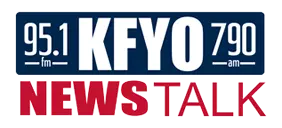
Chad’s Morning Brief: Is Ted Cruz Eligible to Run for President, Will He? Texas Lawmakers Consider Slashing CHL Training Time, & More
Here is your Morning Brief for the morning of March 21, 2013. Give Chad your feedback below and tune in to The Chad Hasty Show for these and many more topics from 8:30 to 11am.
1. Cruz 2016? (link)
The Washington Post is looking ahead to 2016 and wondering if Senator Ted Cruz should run for President. Though the first question they ask... and sorta answer is if he can actually run. I have even heard from listeners on this issue regarding whether Cruz can run for President.
The answer according to the Post is yes... probably.
Cruz, like a couple of presidential candidates before him, faces a potential hurdle to running for president in that it’s not 100 percent clear that he’s a “natural-born citizen,” as the 14th Amendment requires presidents to be.
Cruz’s mother was a U.S. citizen when he was born, and current U.S. law extends citizenship to anyone born to a U.S. citizen, regardless of where the birth takes place. The question is whether citizenship is the same thing as being a “natural-born citizen.”
Legal scholars generally agree that Cruz meets that requirement, and Cruz’s office agrees. But it also remains somewhat untested in the courts.
While no president-elect has formally tested the “natural-born citizen” requirement, several have run for president with that question hanging over their candidacies.
Democrats in 1967 suggested that George Romney would not be eligible to serve as president, because he was born to U.S. citizens in Mexico. But a New York Law Journal piece at the time argued forcefully that he would be, and that seemed to put the issue to rest. (Romney’s primary campaign wound up imploding.)
Sen. John McCain (R-Ariz.), the GOP’s nominee in 2008, was born in the Panama Canal Zone to U.S. citizens. After he secured the party’s nomination, the Senate in 2008 passed a resolution stating that McCain was indeed a natural-born citizen.
In fact, this debate dates back to President Chester Arthur and the original so-called “birther” controversy. While Arthur is listed as being born in Vermont, some argued that he was born in Canada and thus ineligible to be president.
The nonpartisan Congressional Research Service has even weighed in on the issue, writing in November 2011 that people born to U.S. citizens in foreign countries “most likely” qualify as natural-born citizens.
“The weight of more recent federal cases, as well as the majority of scholarship on the subject, also indicates that the term ‘natural born citizen’ would most likely include, as well as native born citizens, those born abroad to U.S. citizen-parents, at least one of whom had previously resided in the United States, or those born abroad to one U.S. citizen parent who, prior to the birth, had met the requirements of federal law for physical presence in the country,” wrote Jack Maskell.
So yes Ted Cruz can run for President. I think.
The next question is, should he in 2016?
My answer right now is absolutely not. Don't get me wrong, I love what Cruz is doing in Washington but folks he has only been there for a short time. For now I'd rather have Rubio or Rand Paul run for President. If Hillary were to run and win, it would set-up a great possible run for Cruz in 2020.
Of course in the next year or so I might change my mind and really be wanting Cruz to seek the White House.
2. CHL Classroom Time (link)
Texas lawmakers are aiming to cut CHL training requirements by 60%. Currently those who take a CHL class spend 10 hours in the classroom. If two Republican lawmakers have their way, classroom time will be down to 4 hours.
State Rep. Dan Flynn of Van and state Sen. Donna Campbell of New Braunfels say their bills (HB 47 and SB 864) streamline the course without threatening public safety. The House Homeland Security and Public SafetyCommittee, composed of seven Republicans (including Flynn) and two Democrats, will consider Flynn’s bill Thursday morning.
“You spend a lot of time taking breaks, you spend a lot of time hearing stories,” Flynn told WFAA last month. “A lot of people want to get their license but they have to take a day off from work or they have to take a whole Saturday to go do this.”
Campbell, whose measure hasn’t been scheduled for a hearing yet, said through a spokesman the course requirements haven’t been revisited since 1995, when they were originally put into the statute, and that individuals will still have to demonstrate proficiency and pass a range exam if the bill becomes law.
The Homeland Security and Public Safety committee heard testimony last week for six hours on bills that would allow CHL holders to carry on college campuses, but did not vote. Many who testified at the hearing cited a state law that allows individuals with CHL’s to carry concealed in the State Capitol. There is even an expedited line through security for license holders.
Bordering states have similar times established for CHL courses: Louisiana requires nine hours of training, Oklahoma requires 8 and New Mexico requires 15. Utah only requires 4 hours of training and Texas honors Utah permits within the state.
Texas “ranks” fourth in the United States in concealed handgun licensees. As of the end of last year, the state popularly known for it’s Wild West culture, registered just over half a million CHL holders, compared to Florida’s 950,000.
I'm not so sure about this. A little inconvenience to get your CHL isn't a huge price to pay. While some people may only need 4 hours of classroom time, other people may need much longer. Is this an urgent need right now?
3. NFL (link)
The NFL continues to pass stupid rule changes that is making it harder and harder to actually enjoy the game. Yesterday the NFL banned ball carriers from using their helmets to make contact. How will this be enforced when a running back lowers their shoulder but it looks like they also lower their head? No one really knows.
NFL owners passed a player safety rule Wednesday barring ball carriers from using the crown of their helmets to make forcible contact with a defender in the open field.
Several coaches and team executives expressed concern about officiating the new rule, but Commissioner Roger Goodell championed it and it passed Wednesday as the owners meetings concluded.
Its passage by a 31-1 vote — Cincinnati voted no — was the second significant step in protecting defensive players; on Tuesday, the league took the peel-back block out of the game.
The tuck rule, one of the most criticized rules in pro football, was eliminated. Now, if a quarterback loses control of the ball before he has fully protected it after opting not to throw, it is a fumble.
Rooney said the Steelers were the only team to vote against getting rid of the tuck rule. New England and Washington abstained.
“We didn’t think it was necessary to make that change,” Rooney said. “We were happy with the way it’s been called.”
Video review now will be allowed on plays when a coach challenges even though he is not allowed to. But the coach will be penalized or lose a timeout, depending on when he threw the challenge flag.
That change stems from Houston’s Thanksgiving victory over Detroit in which Lions coach Jim Schwartz challenged a touchdown run by the Texans’ Justin Forsett. Although officials clearly missed Forsett being down by contact before breaking free on the 81-yard run, when Schwartz threw the red flag on a scoring play that automatically is reviewed, the referee could not go to replay.
That loophole has been eliminated.
Other Top Stories:
These and many more topics coming up on today’s edition of The Chad Hasty Show. Tune in mornings 8:30-11am on News/Talk 790 KFYO, streaming online at kfyo.com, and now on your iPhone and Android device with the radioPup App. All guest interviews can be heard online in our podcast section after the show at kfyo.com.
More From News/Talk 95.1 & 790 KFYO








